October’s Uptober market belongs to both the lively new Binance meme and some old coins that have long been ignored.
In the jargon, these old coins are called "Dino Coins," which refer to mature tokens that pioneered certain tracks but whose initial enthusiasm has gradually faded.
For example, ZEC (Zcash) soared from a low of around $53 at the end of September to $230 a week after National Day, a monthly increase of over 370%. The revival of the old coin wasn't driven by institutional buying or technological upgrades; it was directly triggered by a tweet.
On October 1st, Naval Ravikant, a legendary Silicon Valley investor with 2.9 million followers, made a highly controversial statement on the X platform: “ Bitcoin is insurance against fiat currency, and Zcash is insurance against Bitcoin. ”
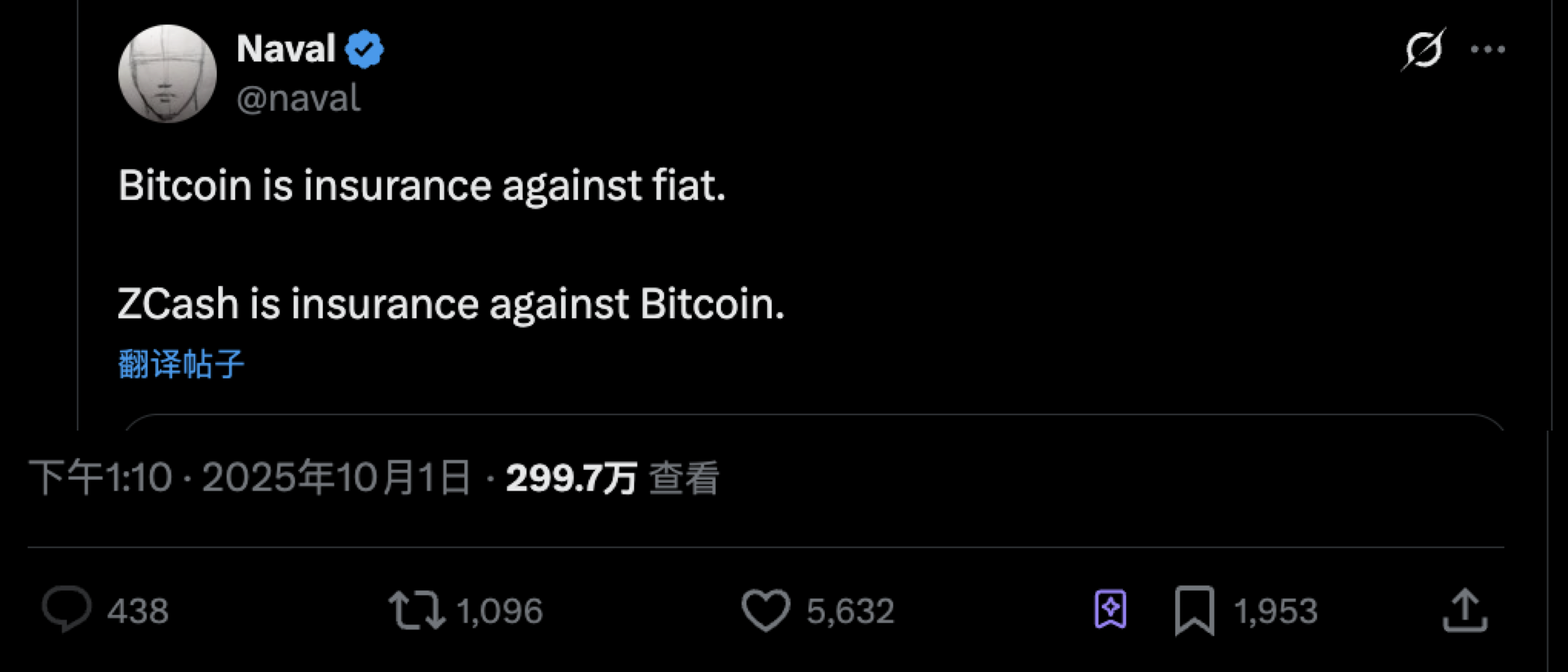
Subsequently, ZEC saw a rapid rise, and other privacy coins also saw long-awaited gains amidst the outpouring of sentiment. Rising prices have their own unique arguing, and the long-dormant privacy narrative has suddenly become a hot topic again.
If you missed this wave of ZEC's growth, you might as well review the whole process of this new wave of old coins with us to see how much influence the big guys have and what opportunities in the privacy track are worth paying attention to next.
Conflicting interests, new calls for old coins
Naval Ravikant is a well-known name in Silicon Valley investment circles. As the co-founder of AngelList, he built this startup financing platform valued at $4 billion.
His personal investment record is also quite impressive, having invested in more than 200 companies including Uber and Twitter in the early stages.
Naval also has extensive experience in the crypto space. In 2014, he co-founded MetaStable Capital, one of the earliest crypto hedge funds. According to public reports, the fund achieved a 540% return in 2017, with early holdings including Ethereum, Bitcoin, and other crypto assets.
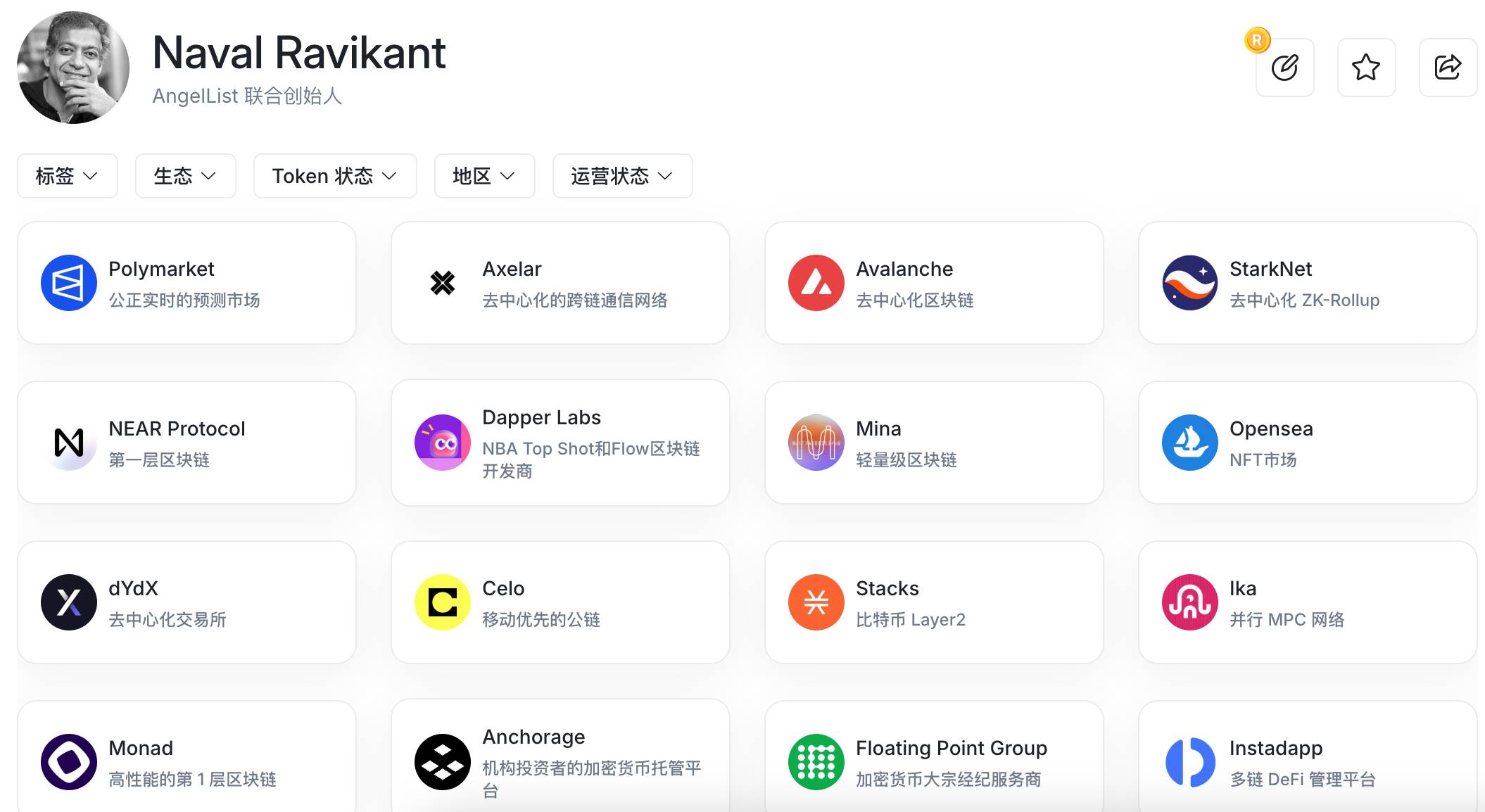
On October 1, Naval tweeted that Zcash was insurance against Bitcoin. Subsequent tweets argued that Bitcoin lacked privacy, pointing out that Bitcoin’s public ledger made it impossible for “Satoshi Nakamoto himself to use Bitcoin” without revealing his identity, and that governments/banks could track all transactions through chain analysis.
Zcash can serve as a supplement to Bitcoin rather than a competitor, using zero-knowledge proof to hide key information such as the sender, receiver, and amount.
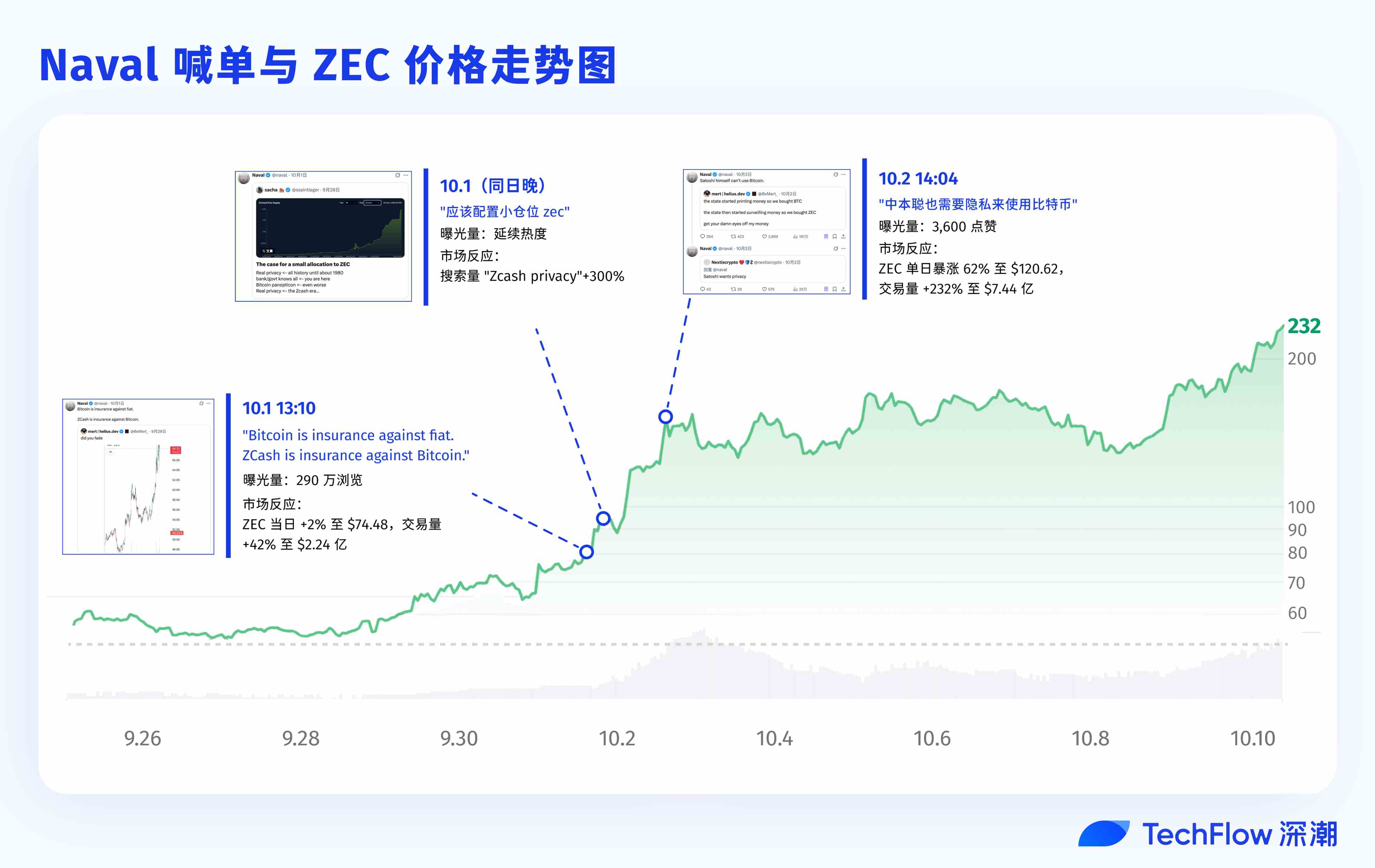
The problem is that these benefits of Zcash are not newly known today. It is more like a big shot occasionally giving a new spin to an old coin. The related privacy narrative has been dead for a long time.
Judging from the timeline, Naval's tweets are highly consistent with the surge in ZEC. However, Naval may not be completely neutral, and there are actually unspoken interests involved.
According to multiple public reports, as early as 2015, Naval invested $715,000 in a company called Zerocoin Electric Coin Company, which was later renamed Electric Coin Company and developed Zcash.
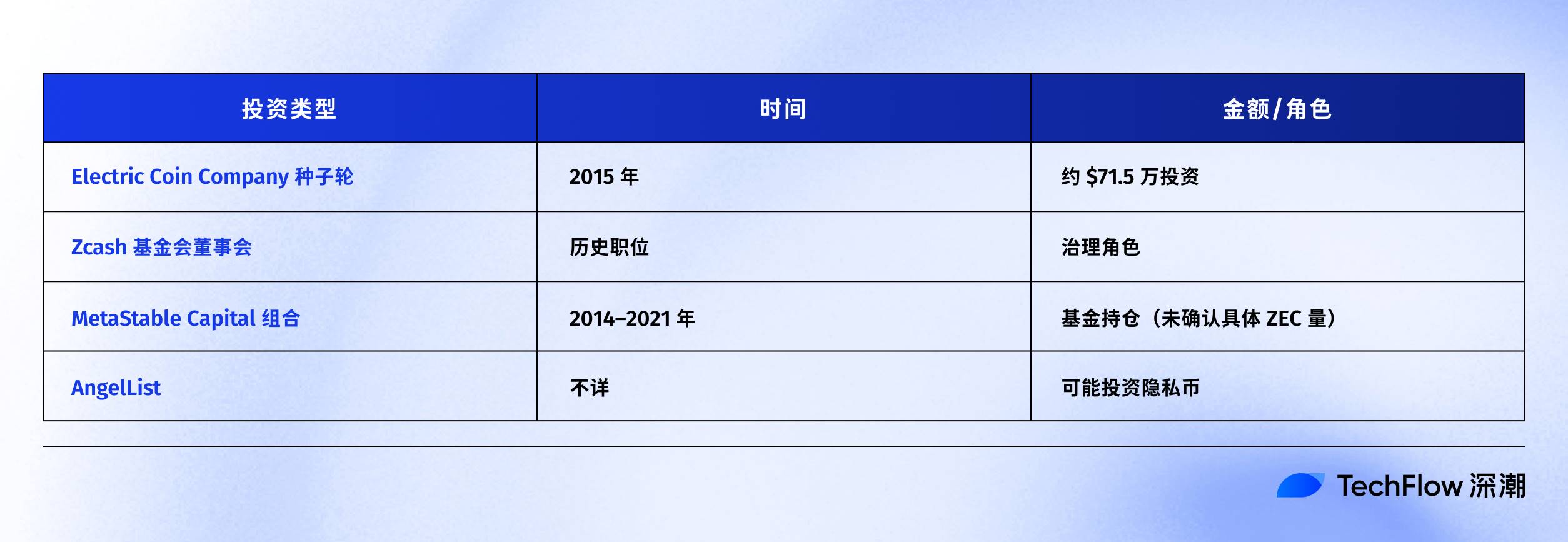
In addition, Naval previously served as a member of the Zcash Foundation’s board of directors and had a certain influence on governance decisions.
Therefore, this investment giant's promotion of old coins has also attracted criticism from the community, who believe that he is using his influence to promote early portfolio projects, and it is difficult to convince people that this is a neutral technical discussion or investment advice.
Interestingly, Naval remained silent on these allegations, neither admitting nor denying them.
Regardless of the controversy, Naval's influence is clearly evident in the price. His tweet garnered 2.9 million views, sparking a flurry of follow-up comments from influential influencers. Balaji Srinivasan (former CTO of a16z) and Mert Mumtaz (CEO of Helius) all posted in support of privacy coins, further fueling market sentiment.
The end result was that ZEC rose from $53 at the end of September to $230, an increase of more than 300% from the time he posted the shill.
Emotional spillover, chain reaction in the privacy track
Naval’s shill not only pushed up ZEC, but the sentiment has spread to the entire privacy coin sector in recent days.
Railgun (RAIL) emerged as the biggest dark horse. This relatively niche privacy coin saw a 240% increase during the same period, from $1.79 to a peak of $4.83. Its 24-hour trading volume surged by 1270%.
In addition to the emotional outpouring from ZEC, Railgun also had the blessing of other catalytic events.
On October 9, the Ethereum Foundation released the Kohaku privacy roadmap, which specifically mentioned the integration of Railgun's zk-multisig technology, which is also one of the privacy features that Vitalik has always favored.
In addition, some other privacy coins also saw good growth.
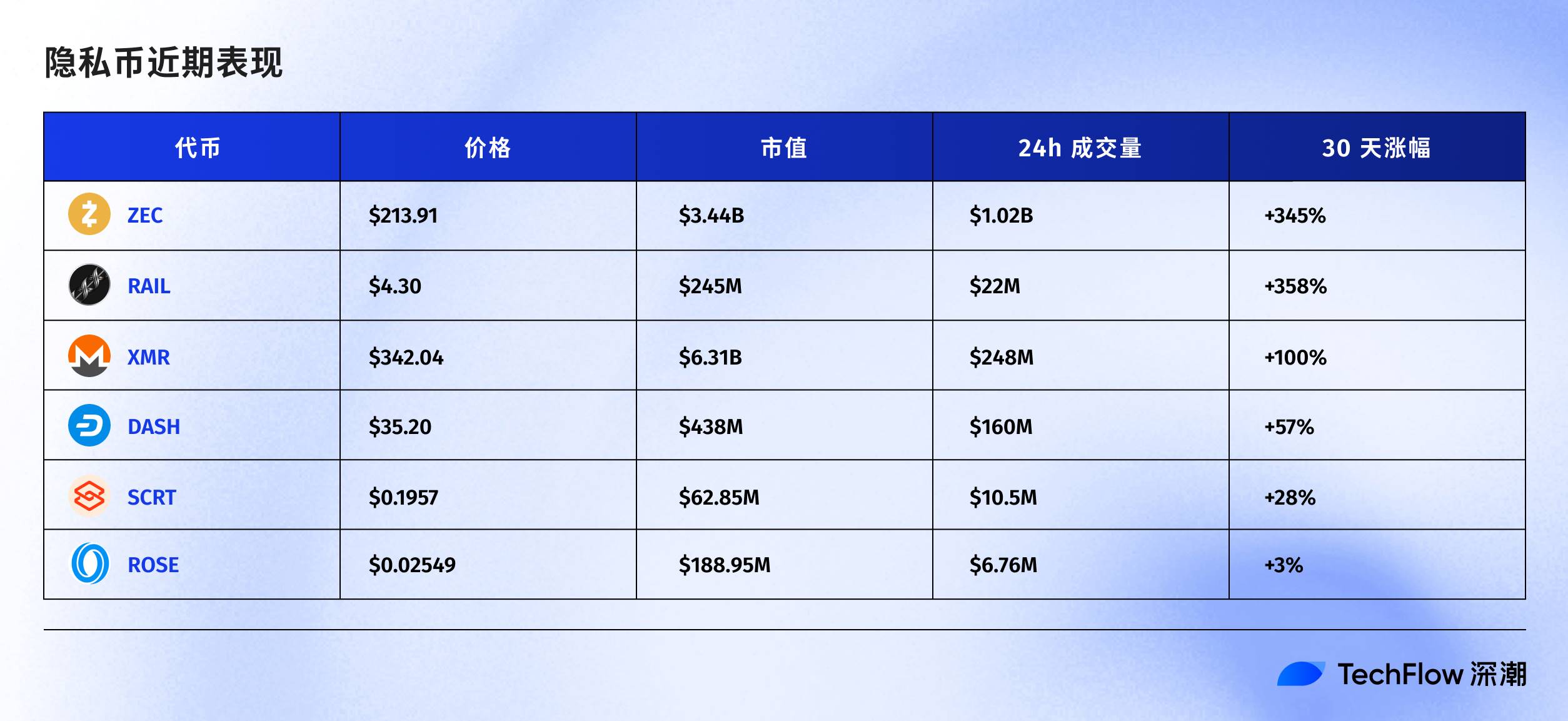
During the surge in ZEC prices, Grayscale also announced that its Zcash Trust would reopen for private placement.
Grayscale Trust is a compliant channel for traditional funds to enter the cryptocurrency market. While not as popular as Bitcoin and Ethereum trusts, it is of great significance to ZEC and is one of the few ways for institutional funds to legally hold ZEC.
According to official website data, Zcash Trust's assets under management (AUM) has reached approximately US$85 million, and the price per share has increased by 340% in six months.
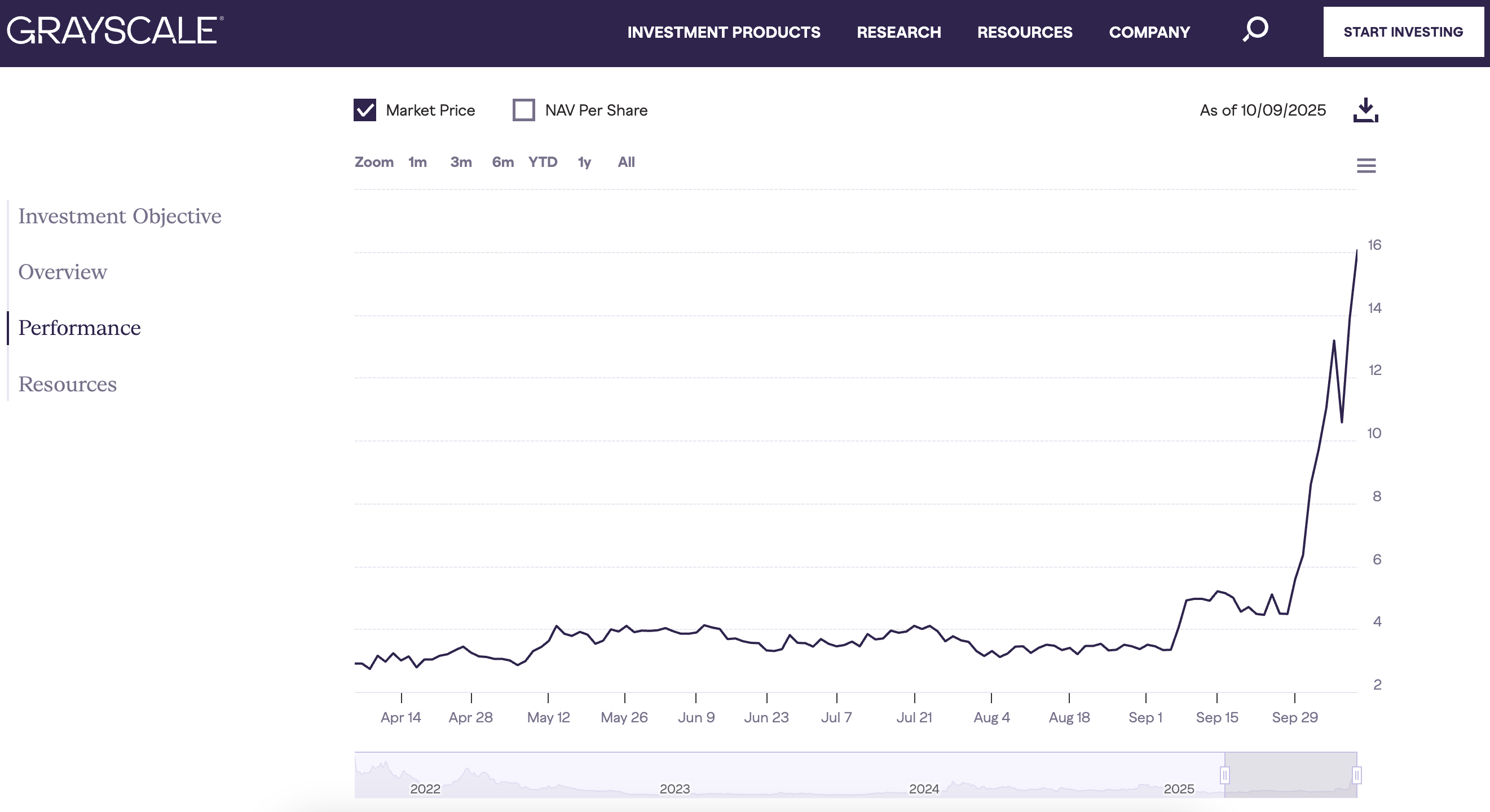
After these announcements were released, the market began to pay attention to the privacy sector again. Although it is difficult to fully calculate the specific data of capital inflow, the increase in social media attention is very obvious.
In addition to the tokens mentioned above, there are also some projects that may also benefit from this short-term sentiment boost from the privacy narrative.
Aster: Dark Pools and Confidential Trading
There is no need to say much about Aster’s popularity, but few people pay attention to its dark pool model.
As an on-chain Perp DEX, one of its highlights is its "Hidden Orders" feature. This allows the size, price, and direction of an order to remain completely invisible until execution, with the result confirmed on-chain only after the trade is completed. This mechanism protects traders from MEV attacks, front-running, and liquidation sniping through zero-knowledge proofs.
Amidst the Binance meme craze and the privacy narrative, $ASTER itself may still be worthy of attention.
Umbra: Auditable Privacy
From October 6th to 8th, Solana's privacy protocol Umbra conducted an ICO on MetaDAO's futarchy platform. Originally aiming to raise $750,000, it ultimately raised $8.8 million, exceeding the target by approximately 1,100%.
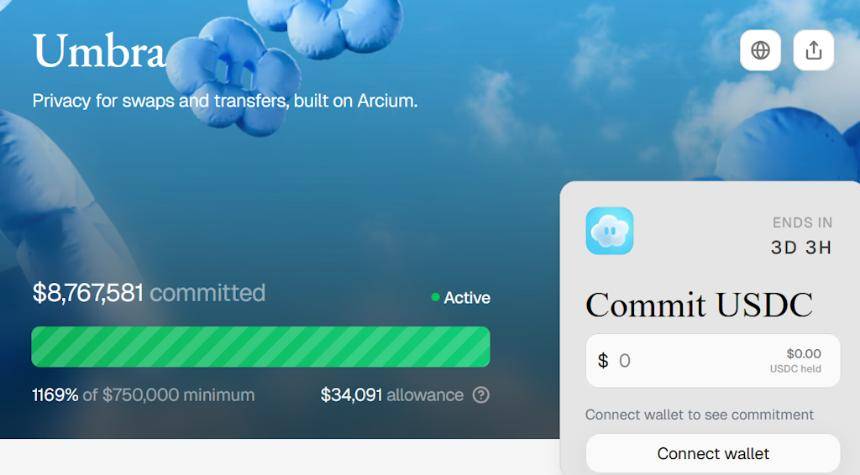
Umbra’s core value lies in providing Solana with a “stealth mode”: through device-side encryption and Arcium’s multi-party computation (MPC) technology, users can make private transfers without sacrificing the verifiability and speed of the blockchain.
Unlike the completely anonymous Monero, Umbra has a built-in compliance framework that creates a cryptographic link between private and public wallets through an auditor process, with information disclosed only under court order. This auditable privacy meets users' need for financial privacy while avoiding the regulatory risks associated with Tornado Cash.
Currently, privacy-related projects on Solana are in their early stages compared to Ethereum. Solana has always been known for its speed and performance, and moving towards privacy will inevitably require support from some leading projects.
Public information indicates that Umbra's mainnet launch is slated for Q1 2026. If all goes well, it could also attract professional traders within the Solana ecosystem who need to prevent front-running, users who require bank-level confidentiality, and institutions seeking compliant privacy tools.
It’s worth mentioning that MetaDAO, which provides a financing platform for Umbra, has also seen its own token META increase by about 191% in the past 30 days. This is another topic related to the launchpad mechanism, which will not be elaborated on due to space limitations.
Ethereum Foundation Kohaku Roadmap: Privacy from the Edge to the Core
On October 8th, the Ethereum Foundation officially released the Kohaku privacy roadmap, marking the first time in Ethereum's history that privacy has been elevated from an "optional feature" to a "protocol-level commitment." Kohaku is a modular, open-source SDK (Software Development Kit) that provides privacy primitives for wallets, allowing developers to easily integrate strong cryptographic functionality. This initiative was personally endorsed by Vitalik Buterin, who established a 47-person Privacy Cluster to coordinate cross-organizational efforts.
Core features include:
- Light client : In-browser verification to avoid trusting RPC nodes to leak IP addresses
- Private transaction flow : Integrate zk-based protocols such as Railgun to achieve confidential sending/receiving
- Social recovery : Through tools such as ZK Email and ZKpassport, you can recover your wallet without exposing your private key.
- dApp single account : Isolate transaction records of different applications to prevent correlation analysis
This isn't about reinventing the wheel, but rather integrating established privacy solutions (such as Railgun and Elusiv) into a unified SDK to lower the development barrier. Ethereum plans to showcase an initial prototype at Devcon in November 2025 and promote native account abstraction (AA) in 2026, making privacy a "default option" rather than a premium feature.
Railgun's zk-multisig functionality is specifically mentioned in the Kohaku roadmap. As an "officially approved" privacy engine, Railgun will gain wider wallet integration via the Kohaku SDK, which was one of the key catalysts for the RAIL token's 270% surge on October 9th.
More broadly, Kohaku represents a fundamental shift in Ethereum’s attitude towards privacy, and privacy tokens on Ethereum may see a short-term surge in hype.
Aztec Mainnet is Coming Soon: Telling the Story of L2 Privacy and Decentralization
Aztec Network is a privacy-first zero-knowledge rollup L2 based on Ethereum. It has raised $119.1 million (led by a16z and Paradigm) and focuses on "programmable privacy", allowing developers to build applications where users can independently control data disclosure.
On September 17, 2025, Aztec deployed the 2.0.3 feature-complete upgrade, which also means that all the mechanisms required for the mainnet are in place.
Aztec's core difference from other privacy solutions lies in "computational privacy": it not only hides transaction amounts and addresses, but also the entire contract execution logic. This paves the way for enterprise adoption.
For example, tokenized assets (RWA) can be settled on-chain without exposing trading strategies, meeting KYC/AML requirements through selective disclosure.
The Aztec roadmap shows that the mainnet Alpha will be launched at the end of 2025, using fully decentralized sequencers and validators, without a transition period of gradual decentralization.
This is in contrast to most L2s, such as Optimism, which actually had centralized sorters in the early stages. Other L2s have also compromised to some extent on the centralization of sorters.
Although infrastructure is not a new narrative and the entire crypto market may not need new L1/L2, there is still a chance to attract some attention and funds by having a unique selling point in the old track.
Overall, most of these projects are in their early stages, but the privacy track is indeed growing from a marginal demand to a necessary option for mainstream on-chain infrastructure, and local opportunities may also exist in this quiet transformation.






